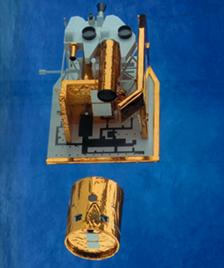Copper Spacecraft to Thrill the World
On July 4th, 2005, beg, borrow or steal a telescope. That's the day the world's first copper spacecraft is scheduled to collide with the comet Tempel 1. The historic collision will be visible by telescope from Earth and will also be televised for the great majority without telescopes.
The collision is expected to help reveal through spectral analysis the primordial materials that formed the solar system some 4 billion years ago. That's when comets were created.
Why is this unique spacecraft made of copper? Because when copper burns-which it will from the enormous force of the impact-it is less likely than other metals to create bright, confusing emission lines in the spectrum of interest, according to Prof. Michael A'Hearn, Department of Astronomy, University of Maryland in College Park. He's one of the astronomers who proposed Deep Impact.
The professor adds that aluminum, for instance, is not suitable for the experiment because it would react with the water in the comet, creating aluminum oxide, and produce very bright emissions that could distort the data.
Two-part Space Vehicle
 The instrument/launch platform (top of rendering) contains two telescopes. The images they gather will be televised to Earth and also directed to on-board spectrographs for analysis. The lower image is the copper impactor just as it parts from the platform
The instrument/launch platform (top of rendering) contains two telescopes. The images they gather will be televised to Earth and also directed to on-board spectrographs for analysis. The lower image is the copper impactor just as it parts from the platformDeep Impact is actually a two-part vehicle, a 1,100-pound impactor that is nearly all copper except for some small rockets and controls for course correction, and an instrument platform with spectroscopes and TV cameras to record the impact. As Deep Impact nears the comet, the two halves will part. While the impactor continues towards the comet at about 22,000 mph, the 1,000-pound platform will pass slowly nearby. Analysis of the impact will be performed by spectrographs on the platform. The images and data will then be transmitted to Earth.
Giant telescopes, including the orbiting Hubble Space Telescope and the newly launched Chandra X-ray telescope, will also be trained on the impact site to gather as much information as possible.
Launch of Deep Impact is planned for January, 2004. It is expected to take 18 months to reach its chosen target on July 4th, 2005. At that time, Tempel 1 will be 80 million miles from Earth and 140 million miles from the Sun.
A 30-year-old Concept
The notion of crashing a space vehicle into a comet to determine its makeup is not new. Science author Sir Arthur C. Clarke first proposed it 30 years ago. Earlier this year, the Lunar Prospector was crashed into the moon to determine if it possessed enough water to sustain a lunar colony. (It doesn't.) Deep Impact is expected to gouge out a 100-foot deep crater in Tempel 1 to expose primordial materials for spectroscopic analysis.
Many scientists and organizations, including the Jet Propulsion Laboratory, are participating in Deep Impact. The craft will be built by Ball Aerospace & Technology, Boulder, Colorado, and launched at a cost of $240 million.
Also in this Issue:
- Copper Quality at Lower Cost
- Energy-Saving Software
- The Advantages of "Engineered"
- Copper Key to Most-efficient Home Heating and Cooling
- Leonardo’s Bronze Horse Installed
- Copper-The Metal for Every Millennium
- Copper Spacecraft to Thrill the World
